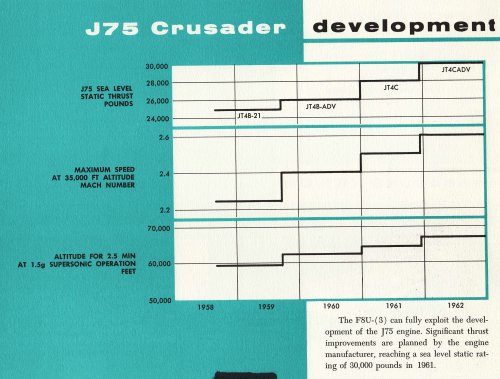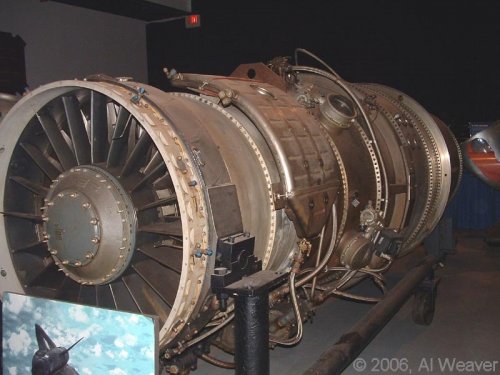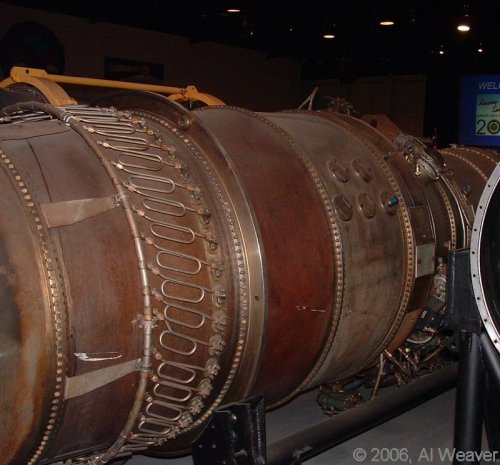KJ_Lesnick said:
Was the F8U-3 as maneuverable as he earlier F8U-1 or -2's?
KJ
The III was around 3500 lbs heavier than the F8U-1 (20,000 lbs dry vs 16,500 dry),
due to it's 3 ft longer wing span, 30 pct greater wing area, and 4 ft longer fuselage,
and other equipment)). But it had a J75 with 25,000 lbs thrust (in burner) vs the
F8U-1's 18,000 lbs thrust (in burner) (the prototype XF8U-3 had 29,000 lbf in burner).
The thrust to weight is reported by some to be around .62 for the F8U-1/2 to .77
for an XF8U-3 with 32,320 lbs of fuel and a J75 with 25,000 lbf in burner.
So the thrust to weight advantage of the III would give it some definite
advantages, and given the glowing praise for the XF8U-3 from its pilots in almost every
piece about it, I wouldn't be surprised that the answer to your question is yes.
There is much praise for it spread throughout the "Wings Of Fame" piece quoted at the
beginning of this thread, from the pilots on the Navy Preliminary Evaluation (NPE) Team
that were assigned to test it.
Also in the book: "Mig Master", by Barrett Tillman, Naval Institute Press, 1980, 1990 (I
have the second edition), two Vought test pilots: John Konrad (chief test pilot) and
Bob Rostine, are reported to have said: "John Konrad and Bob Rostine, both considered
it the finest aircraft they had ever flown."
And I digress about the III vs the Phantom: there are those amusing stories, when
after the F4H won the flyoff, and the XF8U-3s went to NASA, that NASA pilots flying
out of Langley, Virginia in their new XF8U-3s, gleefuly bounced Phantoms undergoing
evaluation at Patuxent River. The Navy test pilots reportedly complained, and the sport
ceased."
I digress some more: The F8U-1 itself was also used as a test vehicle for XF8U-3
technology. In "Mig Master" there is mention of a March, 1958 event where
Bob Rostine got into trouble in an dash-one during landing while testing an
experimental leading edge for the XF8U-3.
But getting back on your question: Former F-8 pilot and retired Rear Admiral Paul Gillcrist,
in his excellent magazine piece: "Crusader vs Phantom"; Flight Journal, December, 1997,
indcates that after 12 years as a Crusader pilot, and 167 combat missions in the F-8 in
Southeast Asia, that the "the F8U-3 design corrected so many of the horrible features
of the F8U-1 and -2 that any Crusader pilot's mouth would have to water at the thought
of taking the big airplane into combat over North Vietnam."
By the way, Rear Admiral Gillcrist was somewhat involved in the XF8U-3, as he was in
Navy Test Pilot School at the time of the flyoff, and took part in some of the briefings
at Vought and McDonnell. He also indicates that the XF8U-3 was only 2000 lbs heavier
(empty) than the F8E, instead of 3500lbs, as I stated above.
He also indicates that the design team at Vought had done a preliminary design on
a variation the the F8U-3, which had a H2O2 powered rocket engine as a booster
to permit a short term 80,000 ft intercept capability !!
I also suggest: Air Classic, Nov. 1977: "Crusader! History of the Navy's Supersonic Fighter".



